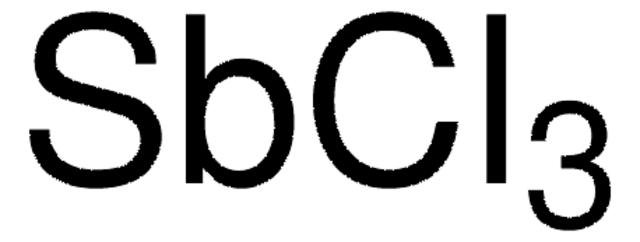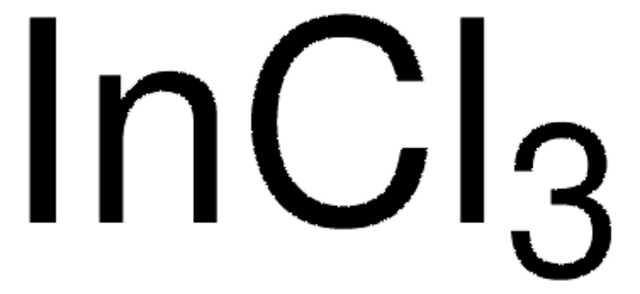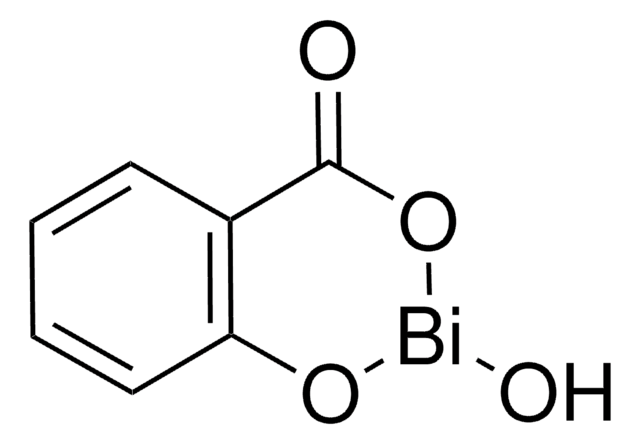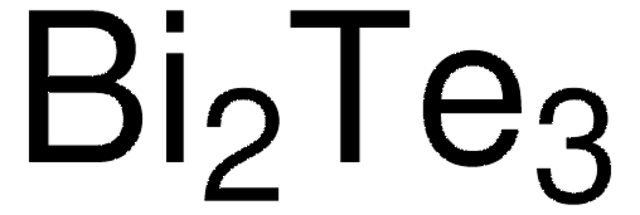推荐产品
等級
for analytical purposes
品質等級
化驗
99.99% trace metals basis
形狀
solid
反應適用性
reagent type: catalyst
core: bismuth
雜質
≤150.0 ppm Trace Metal Analysis
bp
447 °C (lit.)
mp
230-232 °C (lit.)
SMILES 字串
Cl[Bi](Cl)Cl
InChI
1S/Bi.3ClH/h;3*1H/q+3;;;/p-3
InChI 密鑰
JHXKRIRFYBPWGE-UHFFFAOYSA-K
正在寻找类似产品? 访问 产品对比指南
一般說明
Bismuth(III) chloride is a Lewis acid catalyst and a common source of Bi3+ ions used in various organic transformations and synthesis of bismuth nanomaterials.
應用
Bismuth(III) chloride can be used:
- As a precursor to prepare polyaniline and bismuth(III) telluride nanohybrids with high thermoelectric performance.
- As a starting material to synthesize visible light absorbing double perovskite semiconductors, such as Cs2AgBiBr6 and Cs2AgBiCl6, eco-friendly alternative to the lead halide perovskites.
- To form a protective layer on anode materials.
- Chalcones by Claisen–Schmidt reaction under solvent-free conditions.
- One-pot three-component synthesis of Propargylamines.
- Coumarins via ultrasound‐assisted Pechmann condensation of phenols with β‐ketoesters.
訊號詞
Warning
危險聲明
危險分類
Eye Irrit. 2 - Skin Irrit. 2
儲存類別代碼
11 - Combustible Solids
水污染物質分類(WGK)
WGK 2
閃點(°F)
Not applicable
閃點(°C)
Not applicable
個人防護裝備
dust mask type N95 (US), Eyeshields, Gloves
其他客户在看
Organic-inorganic nanohybrids as novel thermoelectric materials: hybrids of polyaniline and bismuth (III) telluride nanoparticles
Naoki Toshima, et al.
Journal of Electronic Materials, 40, 898-902 (2011)
Yunqing Zhu et al.
ACS nano, 8(5), 5022-5031 (2014-04-09)
Homopolymers have been considered as a nonideal building block for creating well-defined nanostructures due to their fuzzy boundary between hydrophobic and hydrophilic moieties. However, this unique fuzzy boundary may provide some opportunities for fabricating functional nanomaterials. Presented in this paper
商品
The prevailing strategies for heat and electric-power production that rely on fossil and fission fuels are having a negative impact on the environment and on our living conditions.
我们的科学家团队拥有各种研究领域经验,包括生命科学、材料科学、化学合成、色谱、分析及许多其他领域.
联系客户支持











